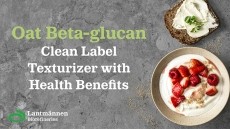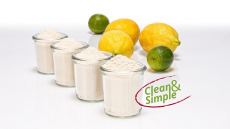Pectin replaces gum arabic for better beverage stability: study
stable orange beverage emulsions, suggests new research from
Malaysia.
The study, published in the journal Carbohydrate Polymers , taps into the growing research trend in beverages for producing emulsions with less or no gum Arabic, a gum historically subject to some supply variations.
"The present study demonstrated that the substitution of 20 per cent Arabic gum with high pectin concentration (three or four per cent weight for weight) resulted in a better storage stability, thus ensuring the adequacy of pectin as a potential replacer for Arabic gum in the formulation of orange beverage emulsion," wrote lead author Hamed Mirhosseini from the Faculty of Food Science and Technology at the Universiti Putra Malaysia.
The supply of gum arabic (E414 in the EU), also known as acacia gum because it comes from Acacia trees in the gum belt of Africa, is variable due to political and climatic factors in the primary producing countries like Sudan and Nigeria and this has led to spikes in the price of the ingredient.
Gum arabic, known as the Rolls Royce' of gums, is widely used by the food and beverage industry, and the top producers (mainly Sudan) bring about 50,000 tonnes of the gum to the market each year.
Attempts to find an alternative have lead researchers to study alternatives that could be used as a thickener, adhesive, and stabiliser for food and beverage applications.
Picking pectin Mirhosseini and co-workers formulated beverage emulsions with two types of hydrocolloids - high methoxy pectin (1.5, 3 and 4.5 per cent, Grindsted Pectin CF 120, provided by Danisco) and carboxymethylcellulose (0.1, 0.3 and 0.5, CMC provided by Suzhou Elifa Chemical Co. China).
The hydrocolloids were tested as replacers for gum Arabic and xanthan gum, respectively.
Beverages were compared to a test beverage formulated with gum Arabic gum (20 per cent), xanthan gum (0.3 per cent), orange oil (14 per cent), citric acid (0.4 per cent), potassium sorbate (0.1 per cent), sodium benzoate (0.1 per cent), and deionised water.
They report that the optimal storage results were obtained by replacing 20 per cent gum Arabic with a pectin concentration of three to four per cent They also report that the composition of the emulsion strongly dictated the release of volatile compounds. "
This finding may be explained by the interactions between emulsion matrix and volatile flavour compounds," stated the researchers.
"The release contents of most of target flavour compounds were significantly decreased during storage, especially for the aldehyde compounds studied (i.e. octanal, decanal, neral, geranial)," they added.
Pectin, with worldwide production estimated at 35,000 tonnes a year, is currently widely used as gelling agents in jams, confectionary, and bakery fillings, and stabilisers in yoghurts and milk drinks.
Researchers from Denmark and England recently highlighted the possibilities of this ingredient and proposed that 'designer' pectin will become increasingly common in the future (Trends in Food Science & Technology, Vol. 17, pp. 97-104).
The functionality of pectin is dictated by the chemical fine structure, and the majority of the pectin used currently comes from citrus peel and apple pomace.
Other sources of the ingredient have remained largely unexploited because of certain undesirable structural properties.
USDA attempts at replacement Researchers from the USDAs Agricultural Research Service, led by Dr. Madhav Yadav, have previously reported initial results of their studies into the potential of a gum produced from corn fibre as a viable and profitable alternative to gum arabic as emulsifiers in beverages.
And the applications for corn fibre gum beyond beverages could possibly include encapsulation of essential oils and fatty acids, glossy coatings and biodegradable edible films, and even as a prebiotics, Dr. Madhav Yadav told FoodNavigator.com in 2006.
To read FoodNavigator.com's coverage of the USDA research, click here .
Source: Carbohydrate Polymers (Elsevier) Volume 73, Issue 1, Pages 83-91 "Influence of pectin and CMC on physical stability, turbidity loss rate, cloudiness and flavor release of orange beverage emulsion during storage" Authors: Hamed Mirhosseini, C.P. Tan, A. Aghlara, N.S.A. Hamid, S. Yusof, B.H. Chern




























